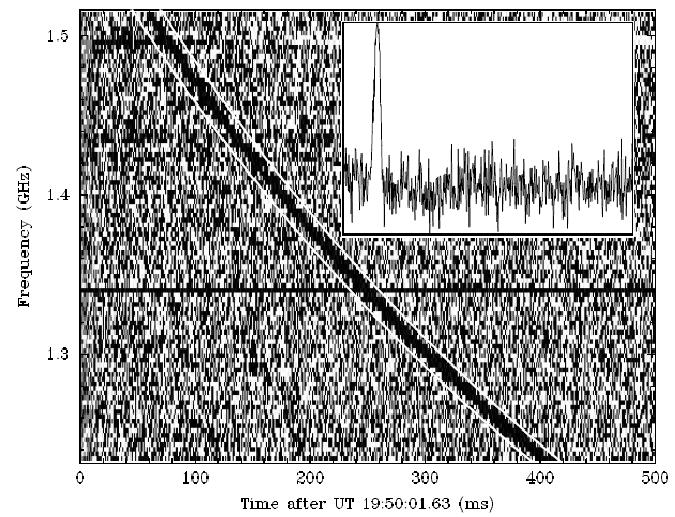“Astropulse:科学原理”的版本间差异
(→Basics) |
|||
| (未显示同一用户的19个中间版本) | |||
| 第1行: | 第1行: | ||
=='''Astropulse 的基本原理== | =='''Astropulse 的基本原理== | ||
| − | |||
| − | |||
===概要=== | ===概要=== | ||
| − | + | [[Astropulse]] 是一种新式的 [[SETI]] 项目。它从原始的 [[SETI@home]] 发展而来,但它并不会替代 SETI@home。先前的SETI@home 是窄频带的,这意味着它只能收听某一特定的频率,这就好像欣赏管弦乐队演奏时尽力去辨别一个“A 升半音音符”,而 Astropulse 监听短时间脉冲。还是拿管弦乐队打比方,这就好像聆听某一记或某一连串鼓击。因为没人猜得到地外文明的信号听上去像什么,搜寻某几种信号听上去是个好主意。就科学而言,Astropulse 是一种以'''微秒'''级的'''瞬时无线电脉冲'''为目标的'''对天空的搜索'''。这些脉冲可能来自地外文明,也可能来自其他来源。我首先解释一下这个定义中使用的一些术语: | |
| − | Astropulse 是一种新式的 SETI 项目。它从原始的 SETI@home 发展而来,但它并不会替代 SETI@home。先前的SETI@home 是窄频带的,这意味着它只能收听某一特定的频率,这就好像欣赏管弦乐队演奏时尽力去辨别一个“A 升半音音符”,而 Astropulse 监听短时间脉冲。还是拿管弦乐队打比方,这就好像聆听某一记或某一连串鼓击。因为没人猜得到地外文明的信号听上去像什么,搜寻某几种信号听上去是个好主意。就科学而言,Astropulse 是一种以'''微秒'''级的''' | ||
* '''天空调查(Sky survey)''':我们使用阿雷西伯望远镜扫描天空,搜索来自每个角落的信号。这有别于定向的 SETI 搜索(那些望远镜对某几个特定恒星进行仔细搜索)。 | * '''天空调查(Sky survey)''':我们使用阿雷西伯望远镜扫描天空,搜索来自每个角落的信号。这有别于定向的 SETI 搜索(那些望远镜对某几个特定恒星进行仔细搜索)。 | ||
* '''微秒(Microsecond)''':就是百万分之一秒。Astropulse 在侦测时间很短的信号方面要优于先前的项目。只要信号长度不小于 0.4 微秒,信号越短,Astropulse 就越有优势。当信号长度小于 0.4 微秒,Astropulse 的优势就不再明显。 | * '''微秒(Microsecond)''':就是百万分之一秒。Astropulse 在侦测时间很短的信号方面要优于先前的项目。只要信号长度不小于 0.4 微秒,信号越短,Astropulse 就越有优势。当信号长度小于 0.4 微秒,Astropulse 的优势就不再明显。 | ||
* '''瞬时的(Transient)''':一个短信号就可以称之为瞬时信号。瞬时信号可能是重复的,也可能是单个的。 | * '''瞬时的(Transient)''':一个短信号就可以称之为瞬时信号。瞬时信号可能是重复的,也可能是单个的。 | ||
| − | * '''无线电(Radio)''':这些信号和 AM 或者 FM 广播一样由电磁辐射构成(大体上来说,信号的频率更高,但还是无线电信号)。电磁辐射包括无线电波,微波,红外线,可见光,紫外线,x射线和伽马射线。在 [ | + | * '''无线电(Radio)''':这些信号和 AM 或者 FM 广播一样由电磁辐射构成(大体上来说,信号的频率更高,但还是无线电信号)。电磁辐射包括无线电波,微波,红外线,可见光,紫外线,x射线和伽马射线。在[[Astropulse:电磁辐射|电磁辐射]]页面可以找到更多有关介绍。 |
| − | + | <br> | |
| − | + | ===一个被侦测到的脉冲=== | |
| + | 天文学家 Duncan Lorimer 和 Matthew Bailes 已经发现了一个短暂的无线电脉冲,据信该脉冲的发源地和地球距离 5 亿秒差距(译注:1 秒差距 = 3.2616 光年),超过十亿光年!那是如此遥远以至于我们甚至不能看到那个星系(也不知道这个星系是否确实存在)。没人知道是什么制造了这个脉冲...是地外文明?还是黑洞爆发?抑或是回转的中子星?下图为该脉冲图像: | ||
[[Image:Lorimer_Bailes_Pulse.jpg]] | [[Image:Lorimer_Bailes_Pulse.jpg]] | ||
| − | + | 在这幅图中,横轴代表时间,纵轴代表频率。这幅图显示脉冲的频率不断减小,这正是我们所盼望的“色散脉冲”(下文有解释)。 | |
| + | <br> | ||
| + | ===脉冲的来源=== | ||
| + | 瞬时无线电脉冲有哪些来源呢?有以下几种可能性,包括: | ||
| − | + | * '''地外文明(ET)''':先前的搜索活动已经通过搜索窄带信号来搜索地外文明(有点类似无线电台)。由于我们并不知道外星人的交流方式,这种办法似乎有些保守。 | |
| + | * '''脉冲星和射电过客(Pulsars and RRATs)''':脉冲星是旋转的中子星,能够产生 100 毫秒级的信号(一般情况下会更长,0.4 毫秒似乎是个极限)。Astropulse 足以胜任对脉冲星的搜索,但并不擅长发现新的脉冲星。射电过客是最近发现的脉冲星的变体。也许 Astropulse 能够发现一类自转周期非常短的新旋转脉冲星类型。 | ||
| + | * '''爆发中的原始黑洞(Exploding primordial black holes)''':Martin Rees 推论认为一个爆发中的黑洞释放出的 Hawking辐射也许会产生能被无线电侦测到的信号。在[[Astropulse:原始黑洞|黑洞]]页面可以找到更多相关信息。 | ||
| + | * '''银河系外脉冲(Extragalactic pulses)''':一些科学家最近发现了一个瞬时的无线电脉冲,它来自银河系外。我们不知道它是如何产生的,但或许Astropulse能发现更多。 | ||
| + | * '''未知的现象(New phenomena)''':也许最有可能的结果是发现一些未知的天体物理学现象。每当天文学家仰望星空,就可能会有新发现,无论是恒星,爆发,星系,还是别的新玩意。 | ||
| − | + | <br><br> | |
| + | =='''色散脉冲'''== | ||
| + | 当毫秒级瞬时无线电脉冲从太空中遥远的某个地方来到我们身边时,它穿过了星际介质(ISM)。星际介质是一种氢原子构成的气体,它弥漫在整个星系中。星际介质和普通的氢气有一点很大的不同。星际介质中的一些氢原子发生电离,电子被剥夺。每有一个电离的氢原子,一个自由电子就在它的周围漂浮。这种由自由漂浮的电离小颗粒组成的物质被称作等离子体。 | ||
| − | + | 微秒级无线电脉冲由许多不同的频率组成。脉冲通过星际介质的等离子体时,高频辐射略快于低频辐射。当脉冲到达地球时,我们观察从 1418.75 MHz 至 1421.25 MHz 信号的部分,这是一个 2.5 MHz 的范围。最高频率辐射到达早于最低频率辐射到达约 0.4 毫秒到 4 毫秒(具体取决于信号距离)。这种现象被称为色射。在[[Astropulse:啁啾脉冲|啁啾脉冲]]页面可以了解色散和非色散脉冲如何由各种不同频率组成。 | |
| − | |||
| − | |||
| − | |||
| − | |||
| + | 为了还原信号的本来面目,我们必须去除这种色散,也就是说,我们必须将信号“消色散”,而“消色散”是 Astropulse 算法的基本目标。 | ||
| − | + | “消色散”不仅让我们看到信号的真面目,还减少了干扰信号能见度的噪音的量。噪音由波动组成,产生错误的信号。比如望远镜中就有电噪声,这会创造一种某处有信号的假象(其实没有)。由于色散会散布一个高达一万倍长度的信号,这会导致一万倍的噪声和真正的信号混在一起。(原注:这种算法有一个平方的效果,所以噪声其实只有信号的一百倍,但这仍是个很大的量。) | |
| − | + | 散射的具体影响程度由地球和信号源之间星际介质等离子体的量决定。“散射量”(dispersion measure,DM)将告诉我们究竟有多少等离子体。DM 以“秒差距每立方厘米”为单位,写作“pc cm-3”。将信号源离地球的距离(以秒差距为单位)乘以电子密度(以电子每立方厘米为单位)(译注:1 秒差距 = 3.2616 光年)即可得 DM 值。所以如果信号源距离地球 2 秒差距,其间充满等离子体,电子密度为每立方厘米 3 个自由电子,则 DM 值为 6pc cm-3。一般情况下宇宙中的电子密度大约是每立方厘米 0.03个自由电子。 | |
| + | <br><br> | ||
| + | ==Astropulse 算法== | ||
| + | ===单脉冲循环=== | ||
| + | 对于任何一个任务单元,Astropulse 都需要处理将近一万五千个不同的 DM 值(精确值为 14208)。而针对每个 DM 值,都需要运行整个“消色散”的算法。最低的 DM 值为 55 pc cm-3,最高为 800 pc cm-3。Astropulse 以一定的 DM 参数值间隔来进行检验。在此不赘述检验某特定 DM 值的方法了,说说 Astropulse 是如何组织与处理数据的:它将 DM 值们分为以 128DM 为单位的大块,然后分为以 16DM 为单位的小块,接着是 4096 字节的小块,然后就可以一小块一小块地进行处理了。一旦将数据消色散处理后,Astropulse 就将这些数据在 10 个不同等级进行叠加,即寻找 0.4 微秒的倍数信号(0.8 微秒、1.6 微秒、3.2 微秒、6.4 微秒…)。Astropulse 在最底层的处理对象是单个的“bin”。一个 bin 相当于两个比特的原始数据,但在消色散之后,我们需要用一个浮点数来表示它。以下是一个 Astropulse 处理循环的详细分解: | ||
| − | + | #1 个任务单元 => 111 个大 DM 块 | |
| + | #1 个大 DM 块 => 8 个小 DM 块 | ||
| + | #1 个小 DM 块 => 2048 个数据块 | ||
| + | #1 个数据块 => 16 个 DM 值 | ||
| + | #1 个 DM 值 => 10 折叠等级 | ||
| + | #1 个折叠等级 => 16384 个 bin(或者更少一些) | ||
| + | #1 个 bin = 最小的处理单元 | ||
| + | 因此,每个任务单元包含 111 个大的 DM 块,每个大 DM 块的计算量是总任务量的 0.901%。每个大 DM 块包含 8 个小的 DM 块,每个小 DM 块的计算量是总计算量的 0.113%,以此类推。 | ||
| − | + | (DM 大块的具体数量可能会在 Astropulse 正式发布时改变) | |
| + | <br> | ||
| + | ===快速折叠算法=== | ||
| − | + | 在每个 DM 大块或 DM 小块处理完成时,Astropulse 将运行快速折叠算法。这种算法以特定时间间隔检查重复的脉冲(该时间间隔就是脉冲重复的周期)。快速折叠算法处理 DM 大块的末尾时,时长为 13 秒,搜索周期为采样频率的 256 倍(256 *0.4 微秒)或更高的重复信号。快速折叠算法处理 DM 小块的末尾时,时长很短,搜索周期为采样频率的 16 倍(16 * 0.4 微秒)或更高的重复信号。 | |
| + | <br><br> | ||
| + | ==相关链接== | ||
| + | *[http://setiathome.berkeley.edu/ap_info.php 项目网站上关于 Astropulse 的介绍] | ||
| − | |||
| − | |||
| − | |||
| − | |||
| − | |||
| − | |||
| − | |||
| − | |||
| − | |||
| − | |||
| − | |||
| − | |||
| − | |||
| − | |||
| − | |||
| − | |||
| − | |||
| − | |||
| − | |||
| − | |||
| − | |||
| − | |||
| − | |||
| − | |||
| − | |||
| − | |||
| − | |||
| − | |||
| − | |||
| − | |||
| − | |||
| − | |||
| − | [[Category:Astropulse]][[Category: | + | [[Category:Astropulse]][[Category:SETI@home]] |
2010年8月2日 (一) 20:42的最新版本
Astropulse 的基本原理
概要
Astropulse 是一种新式的 SETI 项目。它从原始的 SETI@home 发展而来,但它并不会替代 SETI@home。先前的SETI@home 是窄频带的,这意味着它只能收听某一特定的频率,这就好像欣赏管弦乐队演奏时尽力去辨别一个“A 升半音音符”,而 Astropulse 监听短时间脉冲。还是拿管弦乐队打比方,这就好像聆听某一记或某一连串鼓击。因为没人猜得到地外文明的信号听上去像什么,搜寻某几种信号听上去是个好主意。就科学而言,Astropulse 是一种以微秒级的瞬时无线电脉冲为目标的对天空的搜索。这些脉冲可能来自地外文明,也可能来自其他来源。我首先解释一下这个定义中使用的一些术语:
- 天空调查(Sky survey):我们使用阿雷西伯望远镜扫描天空,搜索来自每个角落的信号。这有别于定向的 SETI 搜索(那些望远镜对某几个特定恒星进行仔细搜索)。
- 微秒(Microsecond):就是百万分之一秒。Astropulse 在侦测时间很短的信号方面要优于先前的项目。只要信号长度不小于 0.4 微秒,信号越短,Astropulse 就越有优势。当信号长度小于 0.4 微秒,Astropulse 的优势就不再明显。
- 瞬时的(Transient):一个短信号就可以称之为瞬时信号。瞬时信号可能是重复的,也可能是单个的。
- 无线电(Radio):这些信号和 AM 或者 FM 广播一样由电磁辐射构成(大体上来说,信号的频率更高,但还是无线电信号)。电磁辐射包括无线电波,微波,红外线,可见光,紫外线,x射线和伽马射线。在电磁辐射页面可以找到更多有关介绍。
一个被侦测到的脉冲
天文学家 Duncan Lorimer 和 Matthew Bailes 已经发现了一个短暂的无线电脉冲,据信该脉冲的发源地和地球距离 5 亿秒差距(译注:1 秒差距 = 3.2616 光年),超过十亿光年!那是如此遥远以至于我们甚至不能看到那个星系(也不知道这个星系是否确实存在)。没人知道是什么制造了这个脉冲...是地外文明?还是黑洞爆发?抑或是回转的中子星?下图为该脉冲图像:
在这幅图中,横轴代表时间,纵轴代表频率。这幅图显示脉冲的频率不断减小,这正是我们所盼望的“色散脉冲”(下文有解释)。
脉冲的来源
瞬时无线电脉冲有哪些来源呢?有以下几种可能性,包括:
- 地外文明(ET):先前的搜索活动已经通过搜索窄带信号来搜索地外文明(有点类似无线电台)。由于我们并不知道外星人的交流方式,这种办法似乎有些保守。
- 脉冲星和射电过客(Pulsars and RRATs):脉冲星是旋转的中子星,能够产生 100 毫秒级的信号(一般情况下会更长,0.4 毫秒似乎是个极限)。Astropulse 足以胜任对脉冲星的搜索,但并不擅长发现新的脉冲星。射电过客是最近发现的脉冲星的变体。也许 Astropulse 能够发现一类自转周期非常短的新旋转脉冲星类型。
- 爆发中的原始黑洞(Exploding primordial black holes):Martin Rees 推论认为一个爆发中的黑洞释放出的 Hawking辐射也许会产生能被无线电侦测到的信号。在黑洞页面可以找到更多相关信息。
- 银河系外脉冲(Extragalactic pulses):一些科学家最近发现了一个瞬时的无线电脉冲,它来自银河系外。我们不知道它是如何产生的,但或许Astropulse能发现更多。
- 未知的现象(New phenomena):也许最有可能的结果是发现一些未知的天体物理学现象。每当天文学家仰望星空,就可能会有新发现,无论是恒星,爆发,星系,还是别的新玩意。
色散脉冲
当毫秒级瞬时无线电脉冲从太空中遥远的某个地方来到我们身边时,它穿过了星际介质(ISM)。星际介质是一种氢原子构成的气体,它弥漫在整个星系中。星际介质和普通的氢气有一点很大的不同。星际介质中的一些氢原子发生电离,电子被剥夺。每有一个电离的氢原子,一个自由电子就在它的周围漂浮。这种由自由漂浮的电离小颗粒组成的物质被称作等离子体。
微秒级无线电脉冲由许多不同的频率组成。脉冲通过星际介质的等离子体时,高频辐射略快于低频辐射。当脉冲到达地球时,我们观察从 1418.75 MHz 至 1421.25 MHz 信号的部分,这是一个 2.5 MHz 的范围。最高频率辐射到达早于最低频率辐射到达约 0.4 毫秒到 4 毫秒(具体取决于信号距离)。这种现象被称为色射。在啁啾脉冲页面可以了解色散和非色散脉冲如何由各种不同频率组成。
为了还原信号的本来面目,我们必须去除这种色散,也就是说,我们必须将信号“消色散”,而“消色散”是 Astropulse 算法的基本目标。
“消色散”不仅让我们看到信号的真面目,还减少了干扰信号能见度的噪音的量。噪音由波动组成,产生错误的信号。比如望远镜中就有电噪声,这会创造一种某处有信号的假象(其实没有)。由于色散会散布一个高达一万倍长度的信号,这会导致一万倍的噪声和真正的信号混在一起。(原注:这种算法有一个平方的效果,所以噪声其实只有信号的一百倍,但这仍是个很大的量。)
散射的具体影响程度由地球和信号源之间星际介质等离子体的量决定。“散射量”(dispersion measure,DM)将告诉我们究竟有多少等离子体。DM 以“秒差距每立方厘米”为单位,写作“pc cm-3”。将信号源离地球的距离(以秒差距为单位)乘以电子密度(以电子每立方厘米为单位)(译注:1 秒差距 = 3.2616 光年)即可得 DM 值。所以如果信号源距离地球 2 秒差距,其间充满等离子体,电子密度为每立方厘米 3 个自由电子,则 DM 值为 6pc cm-3。一般情况下宇宙中的电子密度大约是每立方厘米 0.03个自由电子。
Astropulse 算法
单脉冲循环
对于任何一个任务单元,Astropulse 都需要处理将近一万五千个不同的 DM 值(精确值为 14208)。而针对每个 DM 值,都需要运行整个“消色散”的算法。最低的 DM 值为 55 pc cm-3,最高为 800 pc cm-3。Astropulse 以一定的 DM 参数值间隔来进行检验。在此不赘述检验某特定 DM 值的方法了,说说 Astropulse 是如何组织与处理数据的:它将 DM 值们分为以 128DM 为单位的大块,然后分为以 16DM 为单位的小块,接着是 4096 字节的小块,然后就可以一小块一小块地进行处理了。一旦将数据消色散处理后,Astropulse 就将这些数据在 10 个不同等级进行叠加,即寻找 0.4 微秒的倍数信号(0.8 微秒、1.6 微秒、3.2 微秒、6.4 微秒…)。Astropulse 在最底层的处理对象是单个的“bin”。一个 bin 相当于两个比特的原始数据,但在消色散之后,我们需要用一个浮点数来表示它。以下是一个 Astropulse 处理循环的详细分解:
- 1 个任务单元 => 111 个大 DM 块
- 1 个大 DM 块 => 8 个小 DM 块
- 1 个小 DM 块 => 2048 个数据块
- 1 个数据块 => 16 个 DM 值
- 1 个 DM 值 => 10 折叠等级
- 1 个折叠等级 => 16384 个 bin(或者更少一些)
- 1 个 bin = 最小的处理单元
因此,每个任务单元包含 111 个大的 DM 块,每个大 DM 块的计算量是总任务量的 0.901%。每个大 DM 块包含 8 个小的 DM 块,每个小 DM 块的计算量是总计算量的 0.113%,以此类推。
(DM 大块的具体数量可能会在 Astropulse 正式发布时改变)
快速折叠算法
在每个 DM 大块或 DM 小块处理完成时,Astropulse 将运行快速折叠算法。这种算法以特定时间间隔检查重复的脉冲(该时间间隔就是脉冲重复的周期)。快速折叠算法处理 DM 大块的末尾时,时长为 13 秒,搜索周期为采样频率的 256 倍(256 *0.4 微秒)或更高的重复信号。快速折叠算法处理 DM 小块的末尾时,时长很短,搜索周期为采样频率的 16 倍(16 * 0.4 微秒)或更高的重复信号。
